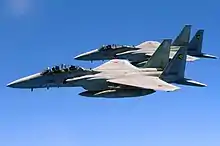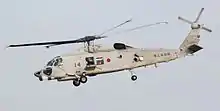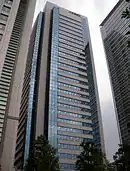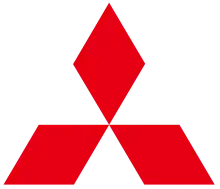Mitsubishi Heavy Industries
Mitsubishi Heavy Industries, Ltd. (三菱重工業株式会社, Mitsubishi Jūkōgyō Kabushiki-kaisha, informally MHI) is a Japanese multinational engineering, electrical equipment and electronics company headquartered in Tokyo, Japan. MHI is one of the core companies of the Mitsubishi Group and its automobile department is the predecessor of Mitsubishi Motors.
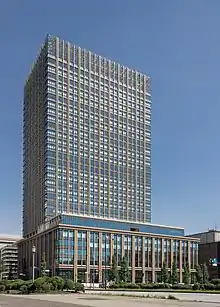 Headquarters in Chūō, Tokyo | |
Native name | 三菱重工業株式会社 |
|---|---|
Romanized name | Mitsubishi Jūkōgyō Kabushiki-kaisha |
| Type | Public KK |
| TYO: 7011 | |
| Industry | Engineering Electrical equipment Electronics Aerospace Defense |
| Founded | 1884 |
| Founder | Iwasaki Yataro |
| Headquarters | Marunouchi Nijūbashi Building, Marunouchi, Chuo, Tokyo, |
Area served | Global |
Key people | Shunichi Miyanaga (Chairman) Seiji Izumisawa President & CEO) |
| Revenue | |
| Total assets | |
| Total equity | |
Number of employees | 81,631 |
| Divisions | Marine Vessel and Ocean Power Engine Machinery and Iron Structure Aviation and Space Medium-size Product |
| Subsidiaries |
|
| Website | www |
MHI's products include aerospace and automotive components, air conditioners, elevators, forklift trucks, hydraulic equipment, machine tools, missiles, power generation equipment, printing machines, ships, aircraft, railway systems, and space launch vehicles.[2][3] Through its defense-related activities, it is the world's 23rd-largest defense contractor measured by 2011 defense revenues and the largest based in Japan.[4]
History
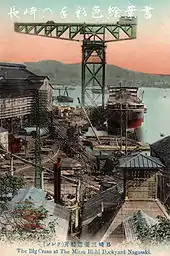
In 1857, at the request of the Tokugawa Shogunate, a group of Dutch engineers began work on the Nagasaki Yotetsusho, a modern, Western-style foundry and shipyard near the Dutch settlement of Dejima, at Nagasaki.[5] This was renamed Nagasaki Seitetsusho in 1860, and construction was completed in 1861. Following the Meiji Restoration of 1868, the shipyard was placed under control of the new Government of Meiji Japan. The first dry dock was completed in 1879.
In 1884, Yataro Iwasaki, the founder of Mitsubishi, leased the Nagasaki Seitetsusho from the Japanese government, renamed it the Nagasaki Shipyard & Machinery Works and entered the shipbuilding business on a large scale. Iwasaki purchased the shipyards outright in 1887. In 1891, Mitsubishi Heavy Industries - Yokohama Machinery Works was started as Yokohama Dock Company, Ltd. Its main business was ship repairs, to which it added ship servicing by 1897.[6] The works was renamed Mitsubishi Shipyard of Mitsubishi Goshi Kaisha in 1893 and additional dry docks were completed in 1896 and 1905.[5]
The Mitsubishi Heavy Industries - Shimonoseki Shipyard & Machinery Works was established in 1914. It produced industrial machinery and merchant ships.[7]
The Nagasaki company was renamed Mitsubishi Shipbuilding & Engineering Company, Ltd. in 1917 and again renamed as Mitsubishi Heavy Industries in 1934. It became the largest private firm in Japan, active in the manufacture of ships, heavy machinery, airplanes and railway cars. Mitsubishi Heavy Industries merged with the Yokohama Dock Company in 1935.[6] From its inception, the Mitsubishi Nagasaki shipyards were heavily involved in contracts for the Imperial Japanese Navy. The largest battleship Musashi was completed at Nagasaki in 1942. The company also housed the Mitsubishi Steel and Arms Works, the Akunoura Engine Works, Mitsubishi Arms Plant, Mitsubishi Electric Shipyards, Mitsubishi Steel and Arms Works, and Mitsubishi-Urakami Ordnance Works, which employed 90% of the city's labor force, and accounted for 90% of the city's industry.[8] These connections made Nagasaki a legitimate target for strategic bombing during World War II by the Allied air forces, which later dropped an atomic bomb on the city on August 9, 1945. This attack, following the atomic bombing of Hiroshima three days earlier, dealt a devastating blow to the Japanese leadership, contributing to the surrender of Japan six days later.
The Kobe Shipyard of Mitsubishi Goshi Kaisha was established in 1905. The Kobe Shipyard merged with Mitsubishi Heavy Industries in 1934. The Kobe Shipyard constructed the ocean liner Argentina Maru (later repurposed as the aircraft carrier Kaiyo), and the submarines the I-19 and I-25.[9]
Following the dissolution of the zaibatsu after the surrender of Japan at the end of World War II, Mitsubishi divided into three companies in January 1950: Mitsubishi Nagasaki became West Japan Heavy Industries, Ltd, the Kobe Shipyard became Central Japan Heavy-Industries, Ltd.,[9] and the Yokohama branch became East Japan Heavy-Industries, Ltd. On 28 April 1952 the Occupation of Japan ended, which meant that the ban on using zaibatsu names was lifted.[10] Accordingly, all three companies changed names again on 7 May 1952: West Japan Heavy Industries (the Nagasaki Shipyard) was renamed Mitsubishi Shipbuilding & Engineering Co., Ltd.,[5] Central Japan Heavy Industries, Ltd. was renamed Shin-Mitsubishi Jukogyo K.K. (also trading as Mitsubishi Heavy Industries, Reorganized, Ltd.;[11] shin meaning "New"), while East Japan Heavy-Industries became Mitsubishi Nippon Heavy Industries.[10]
In 1964, the three independent companies from the 1950 break-up were merged into Shin-Mitsubishi Jukogyo and became Mitsubishi Heavy Industries, Ltd. The Nagasaki works was renamed the Nagasaki Shipyard & Engine Works. The Kobe works was renamed the Mitsubishi Heavy Industries - Kobe Shipyard & Machinery Works.[12]
In 1970, MHI's automobile parts department became an independent company as Mitsubishi Motors.
In 1974, its Tokyo headquarters was targeted in a bombing that killed eight people.
MHI participated in a ¥540 billion emergency rescue of Mitsubishi Motors in January 2005, in partnership with Mitsubishi Corporation and Mitsubishi Tokyo Financial Group.[13][14] As part of the rescue, MHI acquired ¥50 billion of Mitsubishi Motors stock, increasing its ownership stake to 15 percent and making the automaker an affiliate again. The emergency rescue was carried out 4 years after a product recall scandal in Japan that was triggered by accusations of Mitsubishi Motors allegedly trying to systematically hide manufacturing defects to avoid recalls, and marketing problems in the US.[13]
In October 2009, MHI announced an order for up to 100 regional jets from the United States-based airline Trans States Holdings.[15][16]
MHI entered talks with Hitachi in August 2011 about a potential merger of the two companies, in what would have been the largest merger between two Japanese companies in history.[17][18] The talks subsequently broke down and were suspended.[19]
In November 2012, MHI and Hitachi agreed to merge their thermal power generation businesses into a joint venture to be owned 65% by MHI and 35% by Hitachi.[20][21] The joint venture began operations in February 2014 and ended in 2020, as Hitachi transferred its shares to MHI.[20][21][22]
In June 2014 Siemens and MHI announced their formation of joint ventures to bid for Alstom's troubled energy and transportation businesses (in locomotives, steam turbines, and aircraft engines). A rival bid by General Electric (GE) has been criticized by French government sources, who consider Alstom's operations as a "vital national interest" at a moment when the French unemployment level stands above 10% and some voters are turning towards the conservative party.[23] The GE proposal ultimately prevailed, however.[24]
MHI had entered the high-speed train business in 1995, with the manufacture of the MLX01 SCMaglev car, a business it exited in 2017 after struggling with the development costs of the Mitsubishi SpaceJet, and disagreements with Central Japan Railway Company over the manufacturing costs of the SCMaglev cars.[25]
Operations
Aerospace
MHI has aerospace facilities in Nagoya, Aichi, Komaki, Aichi and Mississauga, Canada.
In the 1950s the company began to re-enter the aerospace industry in earnest. Along with other major Japanese companies it was involved in design and production of the NAMC YS-11, the first Japanese airliner to enter production after World War II.[26] In 1956 work started on the design of the Mitsubishi MU-2, which became the company's first postwar aircraft design.[27]
In the defense sector, MHI has produced jet fighters for the Japan Air Self-Defense Force and anti-submarine helicopters for the Japan Maritime Self-Defense Force, as well as aero-engines, missiles and torpedoes. It produced North American F-86 Sabre, Lockheed F-104 Starfighter and McDonnell Douglas F-4 Phantom II fighters. It manufactured 139 Mitsubishi F-15J fighter aircraft from 1981 and produced 200 Sikorsky S-70 family Mitsubishi H-60 helicopters from 1989, in both cases under license production. The company also plays an important role in the Japanese Ballistic Missile Defense System program.
In the space systems sector, MHI is the producer of the H-IIA and H-IIB launch vehicles, Japan's main rockets, and provides launch services for national institutions and companies around the world. The clients include JAXA, KARI, Mohammed bin Rashid Space Centre, and Inmarsat.[28][29][30] The company is also involved in the International Space Station program as a cargo spaceship contractor.[31]
On 1 April 2008, MHI established Mitsubishi Aircraft Corporation as a subsidiary to develop and produce the MRJ or Mitsubishi Regional Jet, a 70 to 90 passenger regional airliner. MHI is the majority shareholder of the new company, with Toyota Motor Corporation owning 10%.[32]
On December 12, 2012, MHI has bought Goodrich turbine business,[33] previously owned by United Technologies.
In the civil aircraft sector, MHI develops and manufactures major airframe components, including fuselage panels for the Boeing 777 and composite-material wing boxes for the 787. In June 2014, the company joined four other major Japanese companies in signing an agreement to build parts for Boeing's 777X aircraft.[34]
On 25 June 2019, MHI announced the acquisition of Bombardier Aviation's CRJ programme, in a deal expected to close in the first half of 2020, subject to regulatory approval.[35] MHI will benefit from Bombardier's global expertise in areas ranging from engineering and certification to customer relations and support, boosting its SpaceJet (formerly MRJ) programme, and potentially enabling the SpaceJet to be produced in North America.[36] The deal includes two service centres in Canada and two in the US, as well as the type certificates for the CRJ.[37] Bombardier will retain its assembly facility at Mirabel, near Montreal, Canada, and will continue to produce the CRJ on behalf of MHI until the current order backlog is complete.[38] In early May 2020, MHI confirmed that all conditions had been met and that the transaction would be closed on 1 June.[39] The acquired aviation unit was then renamed MHI RJ Aviation Group.[40]
MHI recorded a loss in FY 2020 partly because of the continuous delays of the first delivery of the SpaceJet.[41] At the height of the COVID-19 pandemic that crippled the aviation industry, MHI decided to put a halt to the project.[42]
Defense
In 2010 MHI commenced production of the Type 10 advanced main battle tank, at a cost of $11.3 million per unit, to replace the Type 90 tank.
Energy
The nuclear business of MHI operates facilities in the cities of Kobe and Takasago in Hyogo Prefecture and in Yokohama, Kanagawa Prefecture. It also operates a nuclear fuel manufacturing plant in Tōkai, Ibaraki which processes 440 Metric tons of Uranium per year.
MHI has also developed the Mitsubishi APWR design. MHI has also signed a memorandum of understanding with Areva for the establishment of a joint venture, Atmea, for their next reactor design ATMEA1.[43]
MHI has also been selected as the core company to develop a new generation of Fast Breeder Reactors (FBR) by the Japanese government.[44] After that announcement was made, MHI established a new company, Mitsubishi FBR Systems, Inc. (MFBR) specifically for the development and realization of FBR technology, starting what is likely to be the most aggressive corporate venture into FBR and Generation IV reactor technology.[45]
As of 2015, MHI was developing a $15.8 billion nuclear power plant in Sinop, Turkey in partnership with Itochu and Engie, which would be its first overseas nuclear project.[46] The deal has been officially scrapped in January 2020, after the feasibility of the project was doubted.[47]
MHI unsuccessfully attempted to acquire the energy business of Alstom in 2014 in order to develop its service network in Southeast Asia. MHI remains interested in acquisitions in the crude oil and gas sectors as of 2015.[48] Following financial difficulties at Areva, MHI announced in 2015 it would make a proposal to take a minority ownership stake in a new entity called inheriting Areva's nuclear reactor business and acquired a 19% stake in the entity in 2017. In 2018, the entity has been named Framatome.[49][50]
In 2020, MHI eventually acquired Hitachi's gas turbine business unit after the two companies had merged their businesses to form a joint venture.[22]
Shipbuilding
Shipbuilding has been a core and historical founding activity for MHI. It was formally started in 1884 when Mitsubishi leased and then acquired the 'Nagasaki Shipyard & Machinery Works' company (founded in 1857 as 'Nagasaki Yotetsusho Foundry'[51]). Subsequently, Mitsubishi progressively became one of the major Japanese shipbuilding companies, building both commercial as well as military ships, including the Yamato-class battleship, Musashi, of the Imperial Japanese Navy during World War II.
MHI has shipbuilding facilities in Nagasaki, Kobe and Shimonoseki, Japan. Nagasaki Shipyard & Machinery Works (三菱重工長崎造船所, Mitsubishi Juko Nagasaki Zosenjo) is the primary shipbuilding division of MHI. It primarily produces specialized commercial vessels, including LNG carriers, and passenger cruise ships.[52]
On 1 December 2017, MHI announced that it will launch two new wholly owned companies on 1 January 2018 in conjunction with reorganization of its shipbuilding business:
- A new subsidiary, Mitsubishi Shipbuilding Co., Ltd., was created to primarily undertake construction of ships that require intensive outfitting and advanced technologies, mainly based on the Yokohama, Shimonoseki and Nagasaki shipyards.
- Separately, Mitsubishi Heavy Industries Marine Structure Co., Ltd. will mainly engage in the manufacture of large ships and marine structures.[53]
In late 2019, MHI, exploring a withdrawal from LNG carrier construction, started to negotiate with Oshima Shipbuilding to divest its historic shipyard located in Koyagi, Nagasaki.[54] On 24 December 2019, Mitsubishi Shipbuilding delivered its first fuel gas supply system for a marine LNG engine.[55]
Wind power
MHI has installed more 3,282 MW worldwide until December 2009, mainly turbines with 1 and 2.4 MW.[56] The company is developing 7-MW-turbines for offshore wind power. Tests are planned for 2013 in Europe.[57]
On September 27, 2013, MHI and Vestas Wind Systems announced a joint-venture named MHI Vestas Offshore Wind to develop offshore wind energy based on Vestas' V164 8.0MW turbine.[58] In 2020, MHI acquired 2.5% of Vestas by transferring its 50% of MHI Vestas to Vestas, and receiving 5 million new Vestas shares.[59]
Products
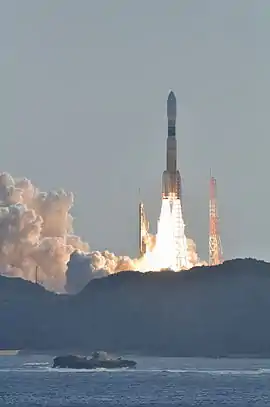

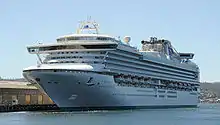
MHI's products include:
- Aerospace systems
- Aircraft
- Space launch vehicles:
- Spacecraft and satellites:
- Air conditioning and refrigeration systems
- Defense
- Armoured fighting vehicles
- Tanks
- Missiles
- AAM-1 (Japanese missile) infrared homing air-to-air missile
- AAM-2 all-aspect infrared homing air-to-air missile
- AAM-3 all-aspect infrared homing air-to-air missile
- AAM-4
- AAM-5
- Nike J surface-to-air missile
- Type 80 Air-to-Ship Missile
- Type 88 Surface-to-Ship Missile
- Type 90 Ship-to-Ship Missile
- Type 91 Air-to-Ship Missile
- Type 93 Air-to-Ship Missile
- Warships
- Torpedoes
- Desalination equipment
- Diesel engines
- Electric buses
- Energy equipment
- Fossil fuel electricity generation equipment
- Fuel cells
- Renewable energy equipment
- Traction batteries.[64]
- Forklifts
- Industrial machinery
- Injection molding machine
- Machine tools
- Compressors
- Paper and printing machinery
- Pepsi Spire
- Railway vehicles
- Crystal Mover
- K-stock metro cars with Rotem - MTR
- Manila Metro Rail Transit System Line 3 RT8D5 LRVs with ČKD Tatra
- Traction motors
- Robots
- Ships and marine structures
- Cruise ships
- Sapphire Princess
- Diamond Princess
- M/S Amadea
- M/S Asuka II
- O'Mega, built as a small cruise ship, but was converted into a luxury yacht between 2002 and 2003.
- AIDAprima[52]
- AIDAperla
- Ferries
- LNG carriers
- LPG carriers
- Oil tankers
- Deep-submergence vehicles
- Chikyū (Ocean-going Drilling Vessel)
- Cruise ships
- Turbochargers
Controversies
On November 28, 2018, MHI was ordered by the South Korea Supreme Court to pay 150m won ($133,000; £104,000) in compensation to 10 surviving Koreans who were victims of forced labor which the company oversaw during the Japanese occupation of Korea.[65][66] Eighteen family members of other victims of the forced labour overseen by MHI, who had previously sued sometime before 2008, were now able to receive the compensation as well by the decision.[66] All twenty-eight plaintiffs had previously filed a lawsuit in Japan, but had their lawsuit dismissed the Supreme Court of Japan in 2008.[66]
The Japanese government has officially disputed the lawsuit and defined the verdict as "a breach of the international law", citing the 1965 agreement which was made by the two nations to establish diplomatic relations, since all of the "problems concerning property, rights, and interests" that had been existed between the two countries and respective peoples thereof during the occupation era "have been settled completely and finally".[67]
Notes
- "MHI Announces FY2019 Consolidated Financial Results" (PDF).
- "Products". Mitsubishi Heavy Industries, Ltd. Archived from the original on 5 January 2012. Retrieved 27 December 2011.
- "Mitsubishi Heavy Industries, Ltd. Global Website | PRODUCTS". Mitsubishi Heavy Industries, Ltd. Retrieved 2020-07-20.
- "Defense News Top 100 for 2011". Defense News. Archived from the original on 6 December 2012. Retrieved 19 July 2012.
- Nagasaki Shipyard & Machinery Works. "History". Archived from the original on 2011-08-07. Retrieved 2011-02-28.
- Yokohama Machinery Works. "Outline". Archived from the original on 2011-08-07. Retrieved 2011-02-28.
- Shimonoseki Shipyard & Machinery Works. "Outline". Archived from the original on 2011-08-07. Retrieved 2011-02-28.
- "Chapter II The Effects of the Atomic Bombings". United States Strategic Bombing Survey.
- Kobe Shipyard & Machinery Works. "Brief History". Archived from the original on 2011-08-07. Retrieved 2011-03-02.
- Toma, Setsuo (2019-08-27). "「モーターファン」誌1952年1月号に載った広告" [Advertising in the January 1952 issue of "Motorfan" magazine]. M-Base (in Japanese). Miki Press. Archived from the original on 2019-12-19.
- Kobe Shipyard & Machinery Works. "Outline". Archived from the original on 2011-08-07. Retrieved 2011-02-28.
- "Mitsubishi's rocky road". The New York Times. 29 January 2005. Retrieved 17 July 2012.
- "Mitsubishi seeks $5.2bn bail out". BBC News. 28 January 2005. Retrieved 17 July 2012.
- "Mitsubishi announces order for 100 regional jets". The Sydney Morning Herald. 2 October 2009. Retrieved 17 July 2012.
- "Japan jet business gets boost with big US order". Reuters. 2 October 2009. Retrieved 17 July 2012.
- "Hitachi, Mitsubishi edge towards groundbreaking merger". Reuters. 4 August 2011. Retrieved 17 July 2012.
- "Shares of Hitachi and Mitsubishi Heavy get merger boost". BBC News. 4 August 2011. Retrieved 17 July 2012.
- "Mitsubishi Heavy, Hitachi shares tumble as merger talks stall". Reuters. 4 August 2011. Retrieved 17 July 2012.
- "Hitachi and Mitsubishi Heavy shares rise after merger". BBC News. 30 November 2012. Retrieved 11 December 2012.
- "MHI, Hitachi plan to merge thermal power units to boost overseas sales". The Japan Times. 30 November 2012. Retrieved 11 December 2012.
- "MHPS changing name as Mitsubishi, Hitachi part ways in joint venture". Power Engineering. 2020-04-27. Retrieved 2020-07-20.
- Jens Hack and Natalie Huet, "Siemens and Mitsubishi challenge GE with Alstom offer", Reuters (June 16 2014).
- "GE Completes Acquisition of Alstom Power and Grid Businesses | GE News". www.ge.com. Retrieved 2020-07-22.
- https://asia.nikkei.com/Business/Mitsubishi-Heavy-to-back-out-of-maglev-train-project
- NAMC YS-11 airliners.net Retrieved December 7, 2016
- Mitsubishi MU-2 airliners.net Retrieved December 7, 2016
- "Mitsubishi Heavy Industries, Ltd. Global Website | MHI Receives Order for Satellite Launch Services from EIAST of UAE". Mitsubishi Heavy Industries, Ltd. Retrieved 2020-07-20.
- "UAE's Amal spacecraft rockets toward Mars in Arab world 1st". ABC 6 NEWS. 2020-07-19. Retrieved 2020-07-20.
- "Inmarsat first customer for new MHI launch vehicle - News". Inmarsat. Retrieved 2020-07-20.
- May 2020, Tariq Malik 20. "Japanese HTV cargo ship, the last of its kind, launches to International Space Station". Space.com. Retrieved 2020-07-20.
- "Toyota to sink $67.2 mln in Mitsubishi passenger jet _World Biz--China Economic Net". Retrieved 7 February 2017.
- United Tech Sells 3 Businesses For $3.5B. Manufacturing.net (2012-12-13). Retrieved on 2013-08-16.
- "Boeing enters pact with Japanese consortium for supply of 777X plane parts". Chicago Chronicle. Archived from the original on 27 July 2014. Retrieved 12 June 2014.
- "Mitsubishi Heavy Industries to Acquire Canadair Regional Jet Program from Bombardier Inc" (Press release). Mitsubishi Heavy Industries. 25 June 2019.
- Hemmerdinger, Jon (6 June 2019). "ANALYSIS: How the CRJ could save the MRJ". Flightglobal.com.
- Chua, Alfred (26 June 2019). "Mitsubishi eager to tap into CRJ expertise". Flightglobal.com.
- "Mitsubishi, Bombardier reach agreement to acquire CRJ program". Leeham News and Analysis. 25 June 2019.
- Hemmerdinger, Jon (7 May 2020). "Mitsubishi to close CRJ purchase on 1 June". Flight Global.
- "Mitsubishi Heavy Industries, Ltd. Global Website | Mitsubishi Heavy Industries Ltd. and Bombardier Inc. have agreed on a June 1, 2020 closing date for the transaction pertaining to the acquisition of Canadair Regional Jet Program". Mitsubishi Heavy Industries, Ltd. Retrieved 2020-07-20.
- "Mitsubishi postpones SpaceJet delivery again, books $4.5 billion special loss". Reuters. 2020-02-06. Retrieved 2020-07-22.
- Shiraki, Tim Kelly, Maki (2020-10-23). "Japan's Mitsubishi Heavy to freeze development of SpaceJet regional jet: sources". Reuters. Retrieved 2020-12-28.
- "JCN Newswire - Asia Press Release Distribution". Archived from the original on 2 June 2013. Retrieved 7 February 2017.
- "Nuclear power in Japan". Archived from the original on 3 March 2008. Retrieved 7 February 2017.
- "JCN Newswire - Asia Press Release Distribution". Archived from the original on 30 June 2013. Retrieved 7 February 2017.
- "2 Japanese companies aim to fund 30% of Turkish nuclear project". Nikkei Asian Review. Nikkei. 8 June 2015. Retrieved 9 June 2015.
- Belgium, Central Office, NucNet a s b l , Brussels. "Turkey / Contract For Sinop Nuclear Station 'Has Been Cancelled'". The Independent Global Nuclear News Agency. Retrieved 2020-07-22.
- Sekiguchi, Keita (6 June 2015). "Mitsubishi Heavy opening up coffers for regional jet, acquisitions". Nikkei Asian Review. Retrieved 8 June 2015.
- "MHI prepares bid for stake in Areva's reactor business". World Nuclear News. 6 November 2015. Retrieved 12 November 2015.
- "MHI agrees to take 19.5% stake in New NP - World Nuclear News". world-nuclear-news.org. Retrieved 2020-07-22.
- http://www.msb.mhi.co.jp/en/company/history/index.html}}
- Wright, Robert (2016-06-21). "Mitsubishi Heavy Industries reviews its future in cruise ships". Financial Times. ISSN 0307-1766. Retrieved 2016-07-24.
- Mitsubishi Shipbuilding. "MHI to Establish Two New Wholly-owned Companies under Reorganization of its Shipbuilding Business". Retrieved 10 January 2018.
- "Mitsubishi Heavy in talks to sell flagship shipyard in Nagasaki". Nikkei Asian Review. Retrieved 2020-07-22.
- "Mitsubishi delivers FGSS for LNG fueled PCC". Marine Log. 2020-01-03. Retrieved 2020-07-22.
- Track Record | Mitsubishi Heavy Industries, Ltd Archived 2012-11-08 at the Wayback Machine. Mhi.co.jp (2010-05-27). Retrieved on 2013-08-16.
- Review of Operations | Mitsubishi Heavy Industries, Ltd Archived 2013-10-02 at the Wayback Machine. Mhi.co.jp. Retrieved on 2013-08-16.
- "Vestas Gains on Mitsubishi Heavy Deal for Offshore Wind". 27 September 2013. Retrieved 7 February 2017 – via www.bloomberg.com.
- Foxwell, David (29 October 2020). "Vestas to acquire offshore JV as it cements future plans with MHI". Riviera. Archived from the original on 29 October 2020.
- GTCC (Gas Turbine Combined Cycle power plant) | Mitsubishi Heavy Industries, Ltd Archived 2012-01-03 at the Wayback Machine. Mhi.co.jp. Retrieved on 2013-08-16.
- Gas Turbines | Mitsubishi Heavy Industries, Ltd Archived 2012-02-26 at the Wayback Machine. Mhi.co.jp. Retrieved on 2013-08-16.
- Steam Turbines | Mitsubishi Heavy Industries, Ltd Archived 2012-02-11 at the Wayback Machine. Mhi.co.jp. Retrieved on 2013-08-16.
- Wind Turbine Generators | Mitsubishi Heavy Industries, Ltd Archived 2008-05-01 at the Wayback Machine
- "Mitsubishi Heavy to make lithium ion car batteries" Archived 2008-01-11 at the Wayback Machine, Reuters, 23 January 2007, as found at Yahoo! Singapore Finance website
- https://www.washingtonpost.com/world/s-korea-court-orders-japans-mitsubishi-to-pay-compensation-for-wartime-forced-labor/2018/11/28/4f0a6616-f37e-11e8-9240-e8028a62c722_story.html
- https://www.bbc.com/news/business-46381207
- "Japan, Korea and the messy question of how to pay for historic wrongs". Los Angeles Times. 2019-08-17. Retrieved 2019-09-09.
References
- Chida, Momohei and Peter N. Davies. (1990). The Japanese Shipping and Shipbuilding Industries: A History of their Modern Growth. London: Athlone Press. ISBN 978-0-485-11271-9; OCLC 20799046
- Kizu, Shigetoshi. (1984). A 100 Years' History of the Ships of Nippon Yusen Kaisha. Tokyo: NYK. ISBN 978-4-905551-20-1; OCLC 16781302
- Ponsonby-Fane, Richard Arthur Brabazon. (1935). The Nomenclature of the N.Y.K. Fleet. Tokyo: NYK. OCLC 27933596
- Wray, William D. (1984). Mitsubishi and the N.Y.K., 1870–1914: Business Strategy in the Japanese Shipping Industry. Cambridge: Council on East Asian Studies, Harvard University, Harvard University Press. ISBN 978-0-674-57665-0; OCLC 10825248

